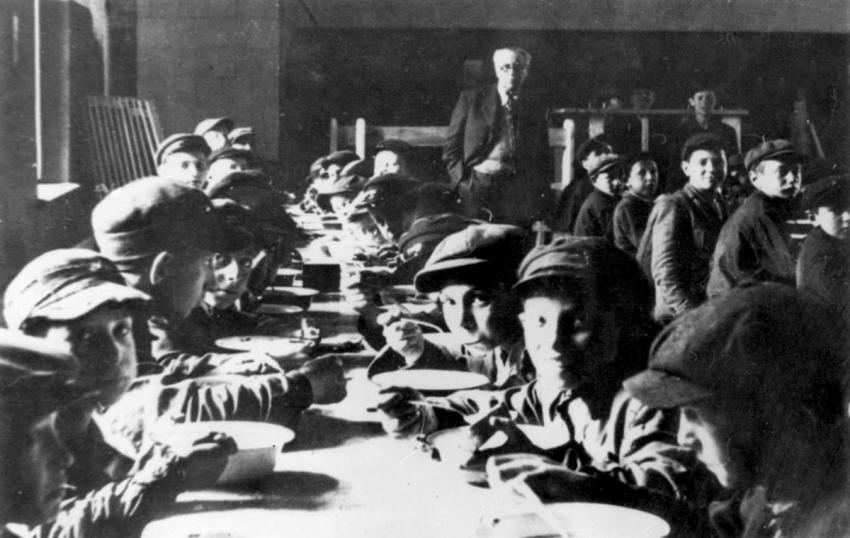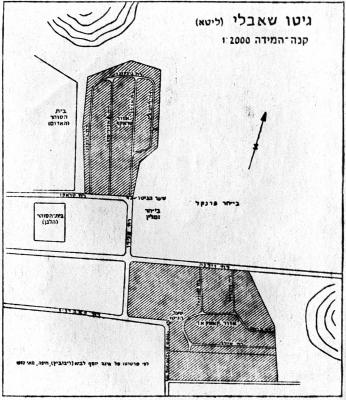Life in the ghetto was organized by a Jewish committee, composed of members who saw themselves fit to serve the community and had volunteered to do so. The committee was ratified by the municipal functionary in charge of the ghetto. Its responsibilities included providing food and housing, social welfare, and the operation of a hospital. The ghetto also contained a courthouse and a Jewish Order Police force. The head of the ghetto was Mendel Leibowitz, a young, affluent and educated Jew, who had been the head of the association for Jewish soldiers who had fought in the Lithuanian War of Independence. Leibowitz maintained good relations with a number of non-Jewish Lithuanians outside of the ghetto. The ghetto’s secretary was Aaron Katz, who was later succeeded by Eliezer Yerushalmi, a teacher at the Hebrew gymnasium, whose ghetto diary survived the war and was published in Israel as the “Šiauliai Notebook”. This diary is an important source for many details regarding the history of the Šiauliai ghetto.
In the first weeks after the ghetto was sealed, 47 children, pupils of the Jewish orphanage, and their teacher Abraham Katz were murdered; also murdered at this time were Jenia Karpel, the ghetto’s economic administrator, 130 sick and elderly people, and 30 Jews considered to be members of the intelligentsia. Selections held at the same time found 90 people to be unable to work – they were deported to Žagarė, where they were murdered. The Jewish committee succeeded in obtaining 500 empty work permits, which they distributed to the community. These permits saved the lives of Jews living in the ghetto, both those originally from Šiauliai and refugees; among the refugees who were saved in this manner were 130 survivors of the massacre at Radviliškis. These organized killing operations came to a halt only at the end of September.
Hundreds of Jews were employed in factories outside the ghetto. Some of them used this as an opportunity to make contact with the outside world; they communicated with messengers from the ghettos in Kovno, Vilna, Riga and Daugavpils. Other Jews were set to work either within the ghetto itself or in the city, working in factories established by the Jewish committee. Many of those working outside the ghetto managed to make a meager living by selling their private belongings to the Lithuanians with whom they worked. These earnings also went towards supporting the ghetto. A group of 750 Jews worked in nearby villages with permission from the authorities, until December 1941, when they were murdered. In May of 1942 a group of Jews from the Šiauliai ghetto was sent to labor camps in Radviliskis, Baciunai and Rakyva. In 1943 another group was sent to the labor camp in Linkaiciai.
In February 1942 a hospital was established in the “Kaukazas ghetto” in Šiauliai; it contained 40 beds, and was established thanks to the efforts of the Jewish committee and funds raised by Jews working in factories both within and outside of the ghetto confines. The hospital was run by Dr. Woolf Peisachovich. The German authorities required Dr. Peisachovich and another Jewish doctor to treat Germans as well as Jews. In addition to the hospital, both parts of the Šiauliai ghetto maintained medical clinics. In August 1942 an edict, originally published in February, came into force, according to which giving birth in the ghetto was a capital offence. Pregnant women were forced to abort their babies, and doctors had to perform hundreds of abortions, even putting infants to death by lethal injection.
Despite the grim conditions, cultural activities continued to be held in the Šiauliai ghetto; holidays and memorial days were observed, and special interest groups and courses were organized. Two schools continued to operate clandestinely from within prayer houses. Youth movements were also active, including Hechalutz, Beitar, and the Communist Youth Movement. The youth movements published underground material in Hebrew, including a booklet entitled Mima'amakim (From the Depths). In August of 1942 a new, nonpartisan educational organization, "Masada", was established in the Šiauliai ghetto; its membership was comprised of 120 youths of various Zionist affiliations. The organization began collecting weapons and providing its pupils with military training. In February of 1943, members of Masada conducted discussions with the Jewish committee concerning plans to resist the Germans in the ghetto and to escape to the partisans; however, these plans were never put into action.








